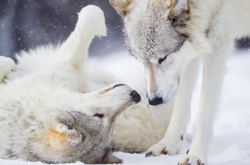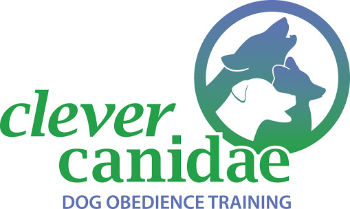What is Canidae?
The Canidae (′kanə′dē) family is a part of the order Carnivora within the mammals (Class Mammalia). Members of the family are called canids and include dogs, as well as wolves, foxes, coyotes, dingoes, jackals, and African Wild Dogs. Because dogs are part of the family Canidae, it gives us insight into their behavior so that we may integrate them into our family successfully. Unlike their wild cousins, dogs have been human companions for centuries, and their desire to be a part of our family is unmistakable.
Do you use shock collars?I believe that there is a time and place for all training methods, however, in most cases a shock collar is expensive and unnecessary equipment. The same results can be obtained with other, more humane methods. I do not use remote electric collars or "shock" collars, and do not recommend prong or choke collars.
What is clicker training?The clicker is used to mark behavior. In other words, it is a form of communication to let your dog know when he/she is doing something right. Timing is very important in dog training. A clicker can help a dog learn more quickly what you are asking him/her to do.
Is my dog too old to learn?Older dogs may require a little more patience when breaking bad habits, however with the right motivation, a dog of any age can learn new tricks!
Why should I do In-Home Training?Training in the dog's natural environment gives you the opportunity to overcome challenges that occur in everyday situations. Unlike group classes, you will receive the trainer's undivided attention, and a personalized training plan. The other advantage is that you will be given the skills to maintain the training, that you would not receive from a in-board training facility. My board and train packages always come with in-home sessions.
How many sessions will it take to change my dog's behavior?Every dog is different, and every situation is unique. A consultation to observe the dog's behavior will help determine the answer to this question. During our sessions, I will give you the skills to communicate effectively with your dog and modify your dog's behavior. However, some behaviors may take longer to change than others. Dog training requires consistency and patience. Basic obedience commands can be learned quickly, but for behavior problems, there is no such thing as a "quick fix."
|
Do you offer a guarantee?Offering a guarantee that your dog will learn or change a specific behavior would be unethical (please refer to the APDT Code of Ethics).
What if my dog can't have or doesn't like treats?Toys and affection are excellent rewards that can be used instead of treats. Every dog is different, the key is to find what motivates your dog. Check out a few of my favorite training treats.
What is the difference between Obedience Training and Behavior Modification?Obedience Training is the process of teaching your dog behavior by giving them a series of cues, commands, and rewards. It also includes teaching your dog proper leash walking, tricks, and basic puppy manners.
Behavior Modification is the process of changing an undesirable behavior that your dog has developed. Examples include barking, chewing, jumping, fearfulness, separation anxiety and aggression. Behavior Modification is much more involved, and requires a consultation by a trained professional to determine the cause of the behavior. Once the cause has been determined, a training plan can be developed. AS GOOD AS A DOG |
|
Contact Us Privacy Policy
Copyright © 2011-2024 Clever Canidae Dog Training. All rights reserved |
